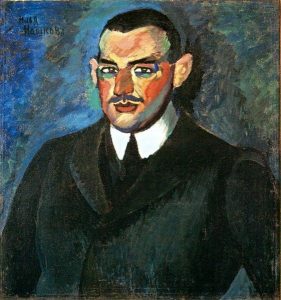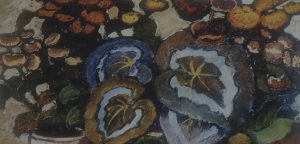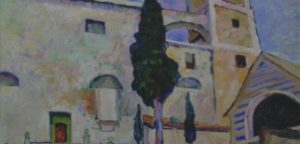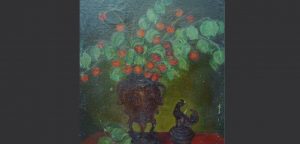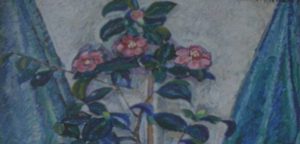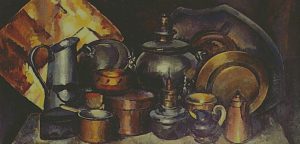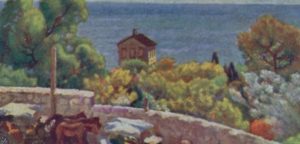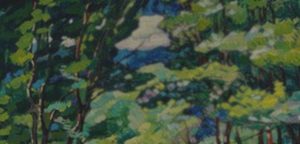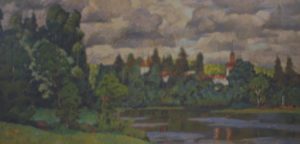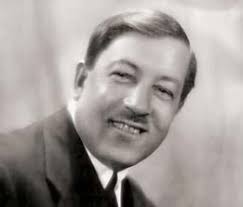Ilya Mashkov was born on the 29th of July in 1881 in the village of Mikhailovska-on-Don, then – the area of the Don Army, Khopersky district, now the Volgograd region.
1881 - 1944
Ilya Mashkov
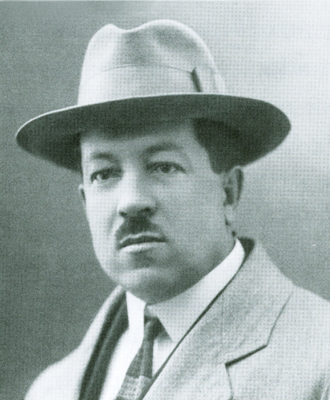
description
A Russian and Soviet painter, still-life master, landscape painter and portraitist, one of the founding members of the exhibition and art association “Jack of Diamonds”, a member of the Society of Moscow Artists.
Ilya was born into the family of “state peasants” engaged in petty trade. He was the oldest of nine children and had to start working at the age of 11.
He worked in the styles of post-impressionism, fauvism, neo-primitivism, in the late period – in the style of postmodernism (“socialist realism”).
He was a member of the movement “The World of Art” (since 1916), the creative group “Moscow painters” (since 1925), and became an active member of the Association of Artists of Revolutionary Russia in 1924-1928. The fame of I. I. Mashkov spread beyond the European continent, since from 1924 works were exhibited in America, Venice, London. Vienna and Paris. He was awarded the title of Honored Art Worker of Russia in 1928, was awarded a gold medal at the International Exhibition in Paris in the late 1930s, received a bronze medal “For Outstanding Contribution to the World Art” in New York.
Key ideas:
– Being one of the organizers of the scandalous exhibition “The Jack of Diamonds”, Ilya Ivanovich Mashkov described the main task of his exposition: “I wanted the painting to be powerful, full of rich color.” Among other things, he presented “Self portrait and portrait of Peter Konchalovsky” – a picture that he called programmatic. The demonstrative corporeality and the celebration of the triumph of the flesh as the trends of the newest art are displayed in their entirety in this canvas. In addition, a double portrait of athletically built and almost nude handsome artists with weights and musical instruments is a real challenge to the academic “mouged and ironed” approach to the image object, and Symbolism that was popular at that time, striving for philosophical skies.
– The researchers refer to the peculiarities of Mashkov’s creative work not only the passionate brightness of pure colors, unrestrained even for “wild ones,” but also the special density of a thick brushstroke. It was not without reason that Mashkov was called “the king of still lifes”, especially during the development of the “poster genre”, when the composition was maximally primitivized.
– Still lifes are remembered due to their expressiveness and what can be called “edibility”, if they depict fruits, bread or other food. I. Mashkov easily sought such an effect, as by nature was kinesthetic, that is, he liked to touch everything, to work with his hands. His artistic talent in the compartment with such a feature allowed a piercing sensuality to appear; the Fauvist idea of displaying the carnal origin in his canvases entirely suited him. And this applies not only to “tasty” still lifes, but also to colorful bathers, whose bodies exude heat, and to landscapes, the air of which, it seems, can be inhaled.
– In the future, the still lifes of the master lose their super-flatness, becoming more voluminous. There is also a softening of the hyperbolized contrast between the texture of fruits and the objects around them.
– There was Mashkov’s special story of depicting female nude. He depicted them almost whole his life. Usually, the figures are devoid of grace, but they are voluminous. The artist emphasizes the corporeality, which strikes with color solutions. Two bathers, for example, are depicted in contrasting greenish (standing) and bright cherry-violet (sitting with her back to the spectator) colors. The artist who created his “I see it” from nature, really often painted the models.
– It should be added that the late works, formerly called socialist Realism, have recently been increasingly interpreted as the style of “postmodernism.”
1881
1892 - 1899
1898
1904
1907 - 1911
1914
1915 - 1916
1924 - 1928
1930
1944
The birth of the artist
N.A. Evseev, a teacher of the local gymnasium, began to teach him drawing
He worked with merchant Yuriev in Borisoglebsk, where N.A. Evseev, a teacher of the local gymnasium, began to teach him drawing.
Entered the Moscow School of Painting, Sculpture and Architecture
Entered the Moscow School of Painting, Sculpture and Architecture (art department), studied with A. Korin, A. Vasnetsov and K. Gorsky, got acquainted with the collections of the Tretyakov Gallery, the Rumyantsev Museum. In 1902, he was awarded the S. Tretyakov Prize for his academic achievements.
He left the school to open his art school-studio
He left the school to open his art school-studio, where he invited at different times N. Goncharov, M. Larionov, P. Kochalovsky and others to teach.
Resumed his studies at the Moscow School of Painting, Sculpture and Architecture
Resumed his studies at the Moscow School of Painting, Sculpture and Architecture (MSPSA) with teachers L. Pasternak, V. Serov, K. Korovin, A. Arkhipov. Made a study tour in Europe. He became one of the active organizers of the exhibition “Jack of Diamonds” and a founding member and secretary of a creative association with the same name. Participated in the Paris Autumn Salon, where his still life with blue plums was highly appreciated by A. Matisse and was bought by patron S. Morozov at the advice of V. Serov.
A trip to Turkey, Egypt, Greece, Switzerland gave an incentive for a creative takeoff
A trip to Turkey, Egypt, Greece, Switzerland gave an incentive for a creative takeoff. Participated in the charitable Commission “Artists – the comrades of warriors”; created a series of “military” pictures-luboks with poems by V. Mayakovsky.
The Tretyakov Gallery purchased two of his works
The Tretyakov Gallery purchased two of his works. Mashkov and P. Konchalovsky entered the World of Art union.
Became a member of the Association of Artists of Revolutionary Russia
Became a member of the Association of Artists of Revolutionary Russia, the society “Moscow painters”. At the APRR (Associations of the Painters of Revolutionary Russia) exhibition in 1925, he exhibited the triptych “Moscow meal”. He became an Honored Artist of Russia.
Received prestigious awards at exhibitions in Paris and New York
After receiving a personal pension, he lived in his homeland, trying to change Mikhailovskaya station. Created a panel for the hotel “Moscow”. Received prestigious awards at exhibitions in Paris and New York.
The death
He died on the 20th of March in 1944 in Moscow.
Ilya Mashkov
On Artist
flow
Fauvism
friends
Petr Konchalovsky
Mikhail Larionov
artists
Henri Matisse
Maurice de Vlaminck
Leonid Pasternak
Valentin Serov
Konstantin Korovin
Apollinary Vasnetsov
Abram Arkhipov
Nikolay Kasatkin
Sergey Miloradovich
By Artist
flow
Modern
artists
Adolf Milman
Alexander Kuprin
Kazimir Malevich
Vasily Yermilov
Robert Falk
Alexey Grishchenko
Vyacheslav Fedorov
Alexander Osmerkin
Heinrich Blumenfeld
Mikhail Rodionov
Alexander Korolev
Ivan Klyun
Vera Mukhina

